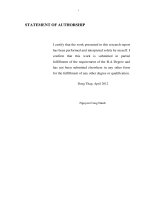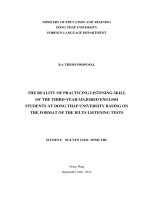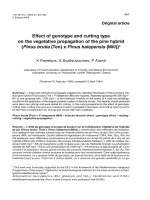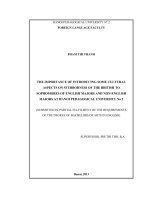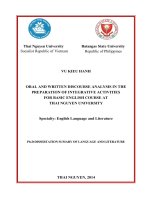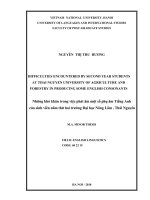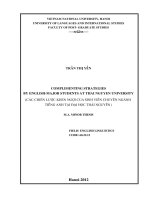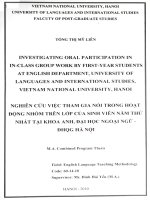Vegetative propagation of taxus chinensis by leafy stem cuttings at vietnam forestry university
Bạn đang xem bản rút gọn của tài liệu. Xem và tải ngay bản đầy đủ của tài liệu tại đây (687.7 KB, 34 trang )
MINISTRY OF AGRICULTURE AND RURAL DEVELOPMENT
VIETNAM FORESTRY UNIVERSITY
STUDENT THESIS
VEGETATIVE PROPAGATION OF TAXUS CHINENSIS BY LEAFY STEM
CUTTINGS AT VIETNAM FORESTRY UNIVERSITY
Major: Natural Resources Management (Advanced Curriculum)
Code: D850101
Faculty: Forest Resources and Environmental Management
Student: Doan Thanh Tung
Student ID: 1153091145
Class: K56 Natural Resources Management
Course: 2011 - 2015
Advanced Education Program
Developed in Collaboration with Colorado State University, USA
Supervisor: Assoc.Prof .Dr. Vu Quang Nam
Hanoi, October 2015
CONTENTS
ACKNOWLEDGEMENTS
ABSTRACT
I.
INTRODUCTION .......................................................................................................... 1
II. GOALS AND SPECIFIC OBJECTIVES ...................................................................... 5
2.1.
Goal . ....................................................................................................................... 5
2.2.
Specific objectives .................................................................................................. 5
III.
STUDY SITE AND METHODS ............................................................................... 6
3.1.
Study site................................................................................................................. 6
3.1.1.
Location ........................................................................................................... 6
3.1.2.
Climate, Hydrology, and Soil .......................................................................... 7
3.2.
Methods .................................................................................................................. 8
3.2.1.
Preparation...................................................................................................... 8
3.2.2.
Field work ........................................................................................................ 9
3.2.3.
Data collection ............................................................................................... 10
3.2.4.
Data analysis .................................................................................................. 10
IV.
RESULT AND DISCUSSION ................................................................................. 11
4.1.
Influence of IBA on rooting ability of Taxus chinensis cutting............................ 11
4.1.1.
Rooted rate of Taxus chinensis cutting .......................................................... 12
4.1.2.
Rooted index of Taxus chinensis cutting ....................................................... 13
4.1.3.
Influence of type of cutting on rooting ability ............................................... 14
4.2.
Influence of NAA on rooting ability of Taxus chinensis cutting .......................... 14
4.2.1.
Rooted rate of Taxus chinensis cutting .......................................................... 16
4.2.2.
Rooted index of Taxus chinensis cutting ....................................................... 17
4.2.3.
Influence of type of cuttings on rooting ability .............................................. 18
V. CONCLUSION ............................................................................................................ 19
REFERENCES
APPENDIX
Appendix 1. Table
Appendix 2. Figure
LIST OF TABLES
Table 4.1. Influence of IBA on rooting ability of Taxus chinensis cutting..........................11
Table 4.2. Influence of NAA on rooting ability of Taxus chinensis cutting ....................... 15
LIST OF FIGURES
Figure 3.1. Luot Mountain of Vietnam Forestry University..................................................7
Figure 4.1. Influence of IBA on rooted rate of Taxus chinensis cutting ............................. 12
Figure 4.2. Influence of IBA on rooted index of Taxus chinensis cutting .......................... 13
Figure 4.3. Influence of type of cuttings on Taxus chinensis rooting ability ...................... 14
Figure 4.4. Influence of NAA on rooted rate of Taxus chinensis cutting............................ 16
Figure 4.5. Influence of NAA on rooted index of Taxus chinensis cutting........................ 17
Figure 4.6. Influence of type of cuttings on Taxus chinensis rooting ability ...................... 18
ACKNOWLEDGEMENTS
To complete the field survey and the final report, I would like to thank the
Management Committee of Quan Hoa Forest Protection Unit and forest rangers of Nam
Dong Forest Protection Stations Nature Reserve; teachers of Vietnam Forestry University,
including Mr. Nguyen Van Ly, and Mr. Nguyen The Huong; and the local people of Bau
Village who helped us during the data collection and fieldwork at the study site.
We also would like to take this opportunity to thank Prof. Nguyen Van Tuan, vice
president of Vietnam Forestry University, the Management Board of Advanced
Curriculum, Educational Department and Sciences, Technology and International
Cooperation Department to release for the performance of my study.
I would like to express deep gratitude to Dr. Vu Quang Nam for his guidance on
writing Thesis Proposal, propagating plant and writing the Final Thesis.
Hanoi, October 2015
Doan Thanh Tung
ABSTRACT
Taxus chinensis is a rare Gymnosperm species with high conservation value in Pha
Phanh forest of Nam Dong Gymnosperm Nature Reserve, Quan Hoa District, Thanh Hoa
Province. Taxus chinensis is listed in the IUCN Red list (2012), Vietnam Red Data Book
(2007), and in Decree 32/2006 of Vietnamese government. Due to its limited distribution
mostly on high limestone mountains areas, vegetative propagation of Taxus chinensis will
help to supply materials for re-planting in many other regions, reduce the cost of
afforestation, and conserve this species. This paper introduces some research results about
leafy stem cuttings technique, including: cutting’s quality and treatment with growth
regulators. Taxus chinensis was collected in Pha Phanh forest, and brought to Luot
Moutain of Vietnam Forestry University for propagation. Experiments were carried out
from July to October to find out the appropriate cutting quality and stimulant. Cuttings
were treated with 2 kinds of growth regulator (IBA: Indole 3 – butyric acid, and NAA: αNaphthalen acetic acid) with 3 different concentrations (500, 1000, and 1500 ppm) then
propagated, watered, and observed daily. After data were collected and analysed, the
results show that in 3 types of cutting, the top of branches treated with NAA had the
highest rooted rate of 84.44%, and had the best root quality; compared with 52.23% of
cuttings treated with IBA. Therefore, the top of branches for cutting, which contain
vegetation punctum, were treated with NAA 1000 ppm which was found to be the most
suitable formula for Taxus chinensis propagation.
I. INTRODUCTION
Vietnam is a country with high biological diversity in the world in terms of flora
and fauna. For flora, it is estimated that about 12,000 to 15,000 species, of which about
30% ofwhich are endemic and 7,000 species are recognized (Nguyen Nghia Thin, 1997).
However, due to many different reasons,many ecosystems in our country have been
seriously degraded. Because of illegal exploitation, many endangered speciesare
threatened, and at risk of extinction. In 1996, Vietnam had 356 plant species at risk of
extinction (Vietnam’s Red Data Book, 1996) and this figure has increased to 450 species in
2007 (Vietnam‘s Red Data Book, 2007). Therefore, conservation of forest genetic
resources will focus on conservation and development of two major groups, which are:
1)genetic conservation of rare forest trees at risk of extinction; and 2) conservation of
forest genetic resources thathavegreat economic value for afforestation.
Most people are familiar with the idea of propagating plants from seeds. However,
many plants naturally have methods of reproducing without the need to produce seed.
There are fewer species of trees that frequently reproduce vegetatively but most can be
persuaded to reproduce by artificial manipulation. Vegetative propagation is the
propagation of vegetative parts of the plant such as leaves, twigs, stems, tubers, meristems,
or coupling of the vegetative parts (grafting) to form new plants. In broad terms, vegetative
propagation includespropagation by cuttings, marcotting, grafting,or tissue culture. Along
with the development of breeding, vegetative propagation techniques have increasingly
widespread application. There are four common reasons why people want to vegetatively
propagate trees: maintenance of exact genetic individuals, propagation of seedless or
irregular flowering trees, avoidance of long juvenile periods, and control of growth forms.
Even with trees easily planted by seed, toput the breeding results into production quickly,
in order to keep certain characteristics, vegetative propagation may still be used.
1
Leafy stem cuttings encourage roots to form on a piece of stem detached from the
parent tree, so that it becomes an independent plant. Vegetative propagation by cuttingis
technically simple, easy to apply, and creates large number of seedlings of equal quality.
This technique is the most widely used for forest trees, in term of number of species and
number of cuttings successfully propagated. Among 30 known conifer species of Vietnam,
more than a half have been propagated by leafy stem cuttings. The technique is intensively
used to conserve endangered conifers. Most of the experiments were carried out from
Autumn to early spring before the conifers pass the dormancy period and new shoots
emerge. The deciding factors in leafy stem cutting techniques are how to make cuttings
have a high rooted rate, stems are formed fromlateral budsor accessory buds;the ability to
produce roots and stems depends on the genetic characteristics of each species, parts of
plant which are taken as seed; as well as cell types of trees, so people have to create
favorable conditions for cuttings to root. The success ofleafy stem cuttingtechniques
depends on many factors such as age of parent trees, light, substrate, temperature, humidity
and so on. The first achievement in propagation by cuttingswas marked by Giordano who
successfully propagated E.camaldulensisin 1961, and was put into reality production. Later
in 1963, Franclet, a French researcher, gave a list of 58 species of Eucalyptus were
successfully propagated by cuttings. Since then, there have beenmanysuccessfully studies
aboutpropagation by cuttings with many different plants, providing high efficiency in
production.
Gymnosperm is one of the most important groups of plants in the world.
Gymnosperm forestshelpto regulate the world's climate, and many species of plants,
animals and fungi depend on Gymnosperm to survive. Gymnosperm provide a major
source of wood for construction, paper products, and it is also important for plastic
suppliesworldwide. Seed of many species is also an important source of food for local
2
people in countries such as Chile, Mexico, Australia, and China. Over 200 gymnosperm
species are at risk of extinction in the world. The most common threats are the overexploitation and deforestation for construction, cattle grazing, and farming; along with the
increase of forest fires. The importance of gymnosperm make their conservation
particularly significant.In Vietnam, many national parks and protected areas have been
established; furthermore, laws and regulations have beenenacted to prevent illegal
exploitation. In recent years, many scientists, domestic institutions, and international
organizations are interested in studies about conservation status of Gymnosperm in
Vietnam. For example, scientists like Prof. Phan Ke Loc, Assoc. ProfessorDr. Nguyen Tien
Hiep, Dr. Leonid Averyanov, Dr. Jacinto Regalado; Organizations like the Institute of
Ecology and Biological Resources (Vietnam Academy of Science and Technology), Forest
Inventory and Planning Institute, Fauna and Flora International(FFI) have contributed a lot
toGymnosperm conservation programs.
Nam Dong Gymnosperm Nature Reserve in Quan Hoa District was established
under Decision 87 in January 8th,2014 by People's Committee of Thanh Hoa Province. It
has an area of 646.95 hectares in the administrative area of Nam Dong Commune. The
objectives of Nam Dong Gymnosperm Nature Reserve are conservation and development
of genetic resources of 6 rare endangered Gymnosperm species, which are Pinus
kwangtungensis,
Cephalotaxus
mannii,
Amentotaxus
argotaenia,
Amentotaxus
yunnanensis, Podocarpus neriifolius and Taxus chinensis. All these gymnosperm species
above are among the species threatened with extinction at international level. Since Nam
Dong Gymnosperm Nature Reserve was established and put into operation, the
conservation progress has just only stopped at protecting the integrity, minimizing the loss
of resources from protected areas. Still lack of understanding the characteristics of biology,
3
ecology, distribution of 6 Gymnosperm species, and especially studiesabout the
propagation one of these species for conservation.
Taxus chinensis, also known as Taxus chinensis (Pilg.) Rehd., belongs to Taxaceae.
In Pha Phanh forest, Taxus chinensisis usually distribute in limestone mountains with the
height more than 850 m. Treehas height of more than 20 m, with diameter from 25 cm to30
cm, some trees have D1.3 more than 50cm; dark brown bark with vertical cracks. Leaves
spiral, arranged in two rows because of the twisted stem, strip shaped, slightly curved;
length from 1.5 cm to 2 cm and width from 2 mm to 3 mm. Seeds in pods, have round or
oval shaped, flat; when it ripes, it is succulent andhave bright redcolor. In term of value,
Taxus chinensis has dark pink wood, smoothly grain, water-resistant, used in construction;
the bark is being studied to treat cancer. In term of conservation, Taxus chinensis is listed
LR (lower risk) in the IUCN Red List (2012), VU (vulnerable) in the Red Data Book of
Vietnam (2007), and Group IIa in Degree 32/2006 of Vietnamese government. Taxus
chinensis is threatened becauseof limited distribution in high mountain areas, low ability of
natural regenerationand over-exploitation by human. Hence, in order to conserve the rare
genetic resources of Taxus Chinensis, I choose the topic: "Vegetative propagation of
Taxus chinensisby leafy stem cuttings at Vietnam Forestry University".
4
II. GOALS AND SPECIFIC OBJECTIVES
2.1. Goal: To conserve the species Taxus chinensis from Pha Phanh Forest, Nam Dong
Nature Reserve by leafy stem cutting.
2.2. Specific objectives
- Determine the influence of type and concentration of growth regulators onrooting
ability of Taxus chinensis cutting.
- Determine the appropriatetypes of cuttingfor propagation by leafy stem cutting
technique.
5
III. STUDY SITE AND METHODS
3.1. Study site
3.1.1. Location
Vietnam Forestry University is located in Xuan Mai Town, Chuong My District,
Hanoi City. Geographical coordinates: North latitude 20058’50’’, East longitude
105030’45’’. The West borders with Hoa Son Commune belonging to Luong Son District,
the South borders with Xuan Mai Town, and the East borders with highway 21A. Luot
Mountain experimental area is located in the transition zone between the lowland on the
east and the hills on the west,so the terrain is relatively simple with low hilly nature and
less separated. It includes 2 contiguous hills about 2 km long running from East to West.
The highest peak (compared to sea level) is 133 m and the second highest peak is 90 m.
The average slope of the study area is 15o.There are 3 main aspects which are Southeast,
Southwest and Northwest. Topographical condition in Luot Mountain is suitable for
planning forest and grazing.
6
Figure 3.1. Luot Mountain of Vietnam Forestry University
3.1.2. Climate, Hydrology, and Soil
Xuan Mai area is located in the humid tropical monsoon of North Vietnam, there
are 2 distinct seasons: the rainy season from April to October, dry season from November
to March. During this period, rainfall is less than evaporation.
According to the data of Vietnam Forestry University’s Weather Station in 2011,
the average temperature in Luot Mountain is 22.7oC. The lowest average temperature is
15.9oC in January, and the highest average temperature is 27.9oC in July. The average
rainfall is 189.1 mm, and the highest rainfall in September is 410.2mm. The number of
rainy day per year is 211 days, and distributed equally average from 16 to 18 days per
month. The average humid is 84.2%, and the highest humid is 87% in March and August.
7
The lowest humid in December is 82%. The average evaporation per year is 60.2 mm. For
specific, the highest evaporation in May is 78.5mm, and the lowest in February is 47.5mm.
Luot Mountain is affected by 2 main wind directions, which are the northeast monsoon blows
from August to September, and the southeast monsoon blows from December to July in the
next year. About soil condition, the main soil in Luot Mountain is Feralit and it develops on
mother’s rock. The process of Feralit is strong and the weathering process happens strongly on
surface leads to yellow soil and brown-yellow. Soil is quite acid with 5.6 pH.
3.2. Methods
With the study about the influence of type and concentration of growth regulators
on
ability to coppice and produce roots of cutting, I set up 2 experiments using 2
chemicals (IBA: Indole 3 – butyric acid, and NAA: α-Naphthalen acetic acid), each
chemicalwith 3 different concentrations which are 500, 1000, and 1500 ppm. Also, each
formula has 1 control experiment(no using growth regulator).
With the study about types of cutting, I test 3 types at 3 different parts of branches
detached from the parent tree, named I, II and III (cutting I: the top of branches, cutting II:
the second part from the top, cutting III: the third part from the top). The length of each
cutting from 8cm to 10 cm. The result is recorded in Table 3.1: Influence of IBA on
rooting ability of Taxus chinensis; and Table 3.2: Influence of NAA on rooting ability
of Taxus chinensis.
3.2.1. Preparation
- Equipment: Knife, secateurs or scissors, plastic basin, covering-net...
- Nursery bed for cuttings: 2 layers (underneath is rock layer with the thick about
5 cm for air circulation and drainage; above is sand layer with the thick about 20 cm for
planting). Nursery bed also contains fungicide (Benlat 0.5%) before place the cutting in the
propagation system 1 to 2 days.
8
- Light covering net: made of black net to cover around 50 - 60% luminosity.
- Humidity covering: made of wood or iron frame, cover with thin clear plastic apron.
- Misting propagation system: It is very important to keep the cutting in a moist
atmosphere, usually by enclosing cuttings in a humid place by spraying cutting with thin
film of water regularly, which then evaporates, will help to cool the cutting, minimize
water loss while still allowing sufficient light to reach the cutting.
3.2.2. Field work
- Cuttings should be selected from healthy vigorous shoots. Many conifers have
apexes that will always grow vertically (othorphically); however, some branches that do
not grow vertically on the mother tree will continue to grow horizontally after they have
rooted. When collecting cuttings it is very important to make sure the leaf or needle of the
cutting does not loose too much water. The cutting wil have limited opportunity to take in
more water until the root emerges, so use a plastic basin contains a little water of in the
bottom. It is also important to keep the cutting cool in shade.
- Remove the cutting from the branch with sharp secateurs. The cutting’s length
from 8 cm to 10 cm. Then trim the lower section of the stem which will be inserted into the
nursery bed, otherwise the tissue will root. The cuttings then are processed by fungicide
(Benlat 0.5%) in 10 minutes. Clean the cuttings with water then leave them dry before
inserting.
- Dipping the newly trimmed end of the cutting into growth regulator, then insert
the cutting into the nursery bed about 2 cm to 3 cm in depth. In order to minimize tissue
damage, it is best to make a small hole in thenursery bed with a stick, and then firm up the
nursery bed around the cutting to give the cutting a secure base.
- Taking care of cutting is the key phase for surviving and rooting ability. Depend
on weather, spray with water often as necessary to maintain high humidity around the
9
cutting. In hot sunny days, spray each 30 minutes for about 30 seconds; in cool days, spray
for 30 seconds for each 1 to 2 hours. It is also important to keep the nursery bed clean by
removing any dead cutting or leave.
- When the cutting has rooted, transfer it to a pot with nutrients or it will become
nutrient stressed. In addition, leaving the rooted cutting for a long time in the nursery bed
will damage the newly formed roots when removing from the nursery bed as they grow,
and become entangled in the nursery bed. After the roots have emerged, the cutting can
start to take in nutrients and water, so place the cutting in a well drained pot containing
nutrious. It is necessary to place the pot in high humidity area, and then gradually reduce
the humidity so that the cutting becomes accustomed to ambient conditions.
3.2.3. Data collection
Data collected by tracking each 10-day observation, include number of cuttings in
each experiment, number of successfully propagated cuttings and number of dead cuttings.
Remove the dead cuttings, only keep the survived ones. The indicators are assessed on the
number rooted, length of root; number of roots per cutting are collected at the last day of
the experiment. The experiment result is recorded in Table 3.3: Root indicators.
3.2.4. Data analysis
Base on the results of data collection in the process of conducting revised and
calculated experiments, the data is analyzed by mathematical statistics method.
-
Rooted rate for each experiment:
Number rooted
Rooted rate (%) = x 100
Total number ofcuttings
-
Rooted index = Average number of roots x Average length of roots
10
IV. RESULT AND DISCUSSION
4.1. Influence of IBA on rooting ability of Taxus chinensis cutting
The experiment result is recorded in the Table 4.1 below:
Table 4.1. Influence of IBA on rooting ability of Taxus chinensis cutting
Root quality
Type of
cutting
IBA
concentration
(ppm)
Number
of
cuttings
Average
number
rooted
Average
rooted
rate (%)
Average
number
of root
per
cutting
Average
length
of root
Rooted
per
index
cutting
(cm)
Control
30
2.33
7.77
1.33
2.76
3.67
Cutting
500
30
6.33
21.10
4.33
4.67
20.22
I
1000
30
15.67
52.23
5.33
5.07
27.02
1500
30
14.67
48.90
4.67
5.20
24.28
Control
30
1.67
5.57
1.33
2.73
3.63
Cutting
500
30
5.67
18.90
3.67
4.83
17.73
II
1000
30
15.33
51.10
4.67
5.03
23.49
1500
30
14.67
48.90
4.33
4.70
20.35
Control
30
0.67
2.23
1.33
2.72
3.62
Cutting
500
30
3.33
11.10
2.33
3.10
7.22
III
1000
30
11.00
36.67
4.00
3.97
15.88
1500
30
11.33
37.77
3.33
4.27
14.22
The data above shows that between 3 types of cutting, Cutting I has the highest
rooted rate and rooted indexwith all 3 concentrations of IBA.So the rooted rate and rooted
index will be assessed by cutting I.
11
4.1.1. Rooted rate of Taxus chinensiscutting
Rooted rate (%)
60
50
40
30
20
10
0
Control
500 ppm
1000 ppm
1500 ppm
Figure 4.1. Influence of IBA on rooted rate of Taxus chinensis cutting
The result from Table 4.1 and Figure 4.1 show that: Different concentration of
growth regulator has different affect on rooting ability of Taxus chinensis cutting. In
control experiment with non-treated cuttings, which doesn’t use growth regulator, the
rooting ability of cutting is very low. The rooted rate is only 7.77%.
With the impact of growth regulator, the rooting ability of cutting increased quite
clearly. Cutting I istreated with IBA with concentration of 500 ppm has rooted rate of
21.10%, for cutting II, the rooted rate of cutting is 18.9%. Cutting III has thelowest rooted
rate (11%). When increase the IBA concentration to 1000 ppm, the highest rooted rate is
52.23% of cutting I; cutting II’s rate is 51.1%, and cutting III still has the lowest rooted
rate (36.67%). When the IBA concentration is 1500 ppm, the rooted rate tends to decrease
to 48.9% with cutting I and II; the rooted rate of cutting III at this concentration is only
37.77%.
12
4.1.2. Rooted index of Taxus chinensis cutting
Rooted index
30
25
20
15
10
5
0
Control
500 ppm
1000 ppm
1500 ppm
Figure 4.2.Influence of IBA on rooted index of Taxus chinensis cutting
To have general assess of Taxus chinensis’s root indicators,I use rooted index, which
calculated by multiplication of average number of root and average length of root. The
result from Table 4.1 and Figure 4.2 shows that: When using different concentration of
IBA, the rooted index doesn’t have much differences with each other, but quiet different
from rooted index of control experiment. For specific, cuttings aretreated with IBA with
the concentration of 1000 ppm have the highest rooted index (27.02 for cutting I, 23.49 for
cutting II, and 15.88 for cutting III). Meanwhile, the rooted index of non-treated cuttings in
control experiment is the lowest, only from 3.62 to 3.67.
13
4.1.3. Influence oftype of cutting on rooting ability
Rooted rate (%)
60
50
40
30
20
10
0
Cutting I
Cutting II
Cutting III
Figure 4.3. Influence of type of cuttings on Taxus chinensis rooting ability
The result from Table 4.1 and Figure 4.3 shows that: When using IBA to stimulate
Taxus chinensis cutting to root, the IBA concentration of 1000 ppmhas the highest rooted
rate (roots are strong and numerous) with all types of cutting, so IBA with the
concentration of 1000 ppm is assessed to be the best formula for IBA growth regulator.
However, rooting ability not only affected by growth regulator, but also by many other
factors, include type of cutting (cutting I, II, and III). Different types of cutting also
capable of producing various saplings.The experiment result also shows that, the older of
cuttings, the lowerof rooting ability. For specific, cutting I has the highest rooted rate
(52.23%), next is cutting II with 51.1%, and cutting III has the lowest rooted rate
(36.67%). The cause of this phenomenon is the lignification.
4.2.
Influence of NAA on rooting ability of Taxus chinensis cutting
The experiment result is recorded in the Table 4.2 below:
14
Table 4.2. Influence of NAA on rooting ability of Taxus chinensis cutting
Root quality
Type of
cutting
NAA
concentration
(ppm)
Number Average Average
of
cuttings
number
rooted
rooted
rate (%)
Average
number
of root
per
cutting
Average
length
of root
Rooted
per
index
cutting
(cm)
Control
30
3.67
12.23
1.67
2.13
3.56
Cutting
500
30
23.00
76.67
4.33
2.97
12.86
I
1000
30
25.33
84.43
4.67
4.17
19.47
1500
30
22.00
73.33
4.67
3.50
16.34
Control
30
2.67
8.90
1.33
1.97
2.62
Cutting
500
30
21.00
70.00
3.33
3.10
10.32
II
1000
30
21.33
71.10
4.33
4.03
17.45
1500
30
19.67
65.57
4.67
3.47
16.20
Control
30
2.33
7.77
1.33
1.87
2.49
Cutting
500
30
16.67
55.57
2.67
2.77
7.39
III
1000
30
17.67
58.90
4.00
3.87
15.48
1500
30
13.00
43.33
3.33
3.67
12.22
The data above shows that among 3 types of cutting, Cutting I has the highest
rooted rate and rooted index with all 3 concentrations of NAA. So the rooted rate and
rooted index will be assessed by cutting I.
15
4.2.1. Rooted rate of Taxus chinensis cutting
Rooted rate (%)
90
80
70
60
50
40
30
20
10
0
Control
500 ppm
1000 ppm
1500 ppm
Figure 4.4. Influence of NAA on rooted rate of Taxus chinensis cutting
Similar to the result of cuttings treated with IBA, the result from Table 4.2 and
Figure 4.4 shows that:the cuttings treated with NAA showing more numerous and stronger
roots compared with non-treated cuttings, so NAA has great effect on stimulating the
rooting ability of Taxus chinensis cutting. The average rooted rate reaches from 43.33% to
84.43%. While in control experiment with non-treated cuttings, the rooting ability of
cuttings is very low,onlyfrom 7.77% to12.23%.
With the same NAA concentration, the rooting ability of cuttings increased quite
clearly depend on type of cutting. For example, from cutting III with the lowest rooted rate
(55.57%) to 70% of cutting II, and finally the highest rooted rate of cutting I with 76.67%.
When increase the NAA concentration to 1000 ppm, the highest rooted rate is 84.43% of
cutting I; cutting II’s rate is 71.1%, and cutting III still has the lowest rooted rate (58.9%).
When the NAA concentration is 1500 ppm, the rooted rate tends to decrease slightly from
16
73.33% of cutting I to 65.57% of cutting II; the rooted rate of cutting III at this
concentration is only 43.33%.
4.2.2. Rooted index of Taxus chinensis cutting
Rooted index
20
18
16
14
12
10
8
6
4
2
0
Control
500 ppm
1000 ppm
1500 ppm
Figure 4.5. Influence of NAA on rooted index of Taxus chinensis cutting
The result from Table 4.2 and Figure 4.5 shows that: With the same type of cutting
but using different growth regulator concentration, the rooted indexalso has differences.
Cuttingsare treated with NAA with concentration of 1000 ppm have the best root quality,
the roots are big and strong, have white colour and many hairs. Cuttingsare treated with
NAA with concentration of 1500 ppm, the roots are short, yellow white colour, and have
callus at the end, so the roots are brittle and easy to break. For specific, cuttings are treated with
NAA with the concentration of 1000 ppm have the highest rooted index (19.47 for cutting I, 17.45
for cutting II, and 15.48 for cutting III). Meanwhile, the rooted index of non-treated cuttings in
control experiment is the lowest, only from 2.49 to 3.56.
17
4.2.3. Influence of type of cuttings on rooting ability
Rooted rate (%)
90
80
70
60
50
40
30
20
10
0
Cutting I
Cutting II
Cutting III
Figure 4.6. Influence of type of cuttings on Taxus chinensis rooting ability
The result from Table 4.2 and Figure 4.6 shows that: the NAA concentration of
1000 ppm has higher rooted rate with all types of cuttings, compared to cuttings are treated
with IBA 1000 ppm, so NAA with the concentration of 1000 ppm is the best growth
regulator. Growth regulator has been shown to speed up the process of root formation. The
experiment result also shows that: cutting I has the highest rooted rate (84.44%), next is
cutting II with 71.11%, and cutting III has the lowest rooted rate (58.9%). So, the most
suitable cutting for propagation is the shoot cuttings with vegetation punctum of Taxus
chinensis.
18
